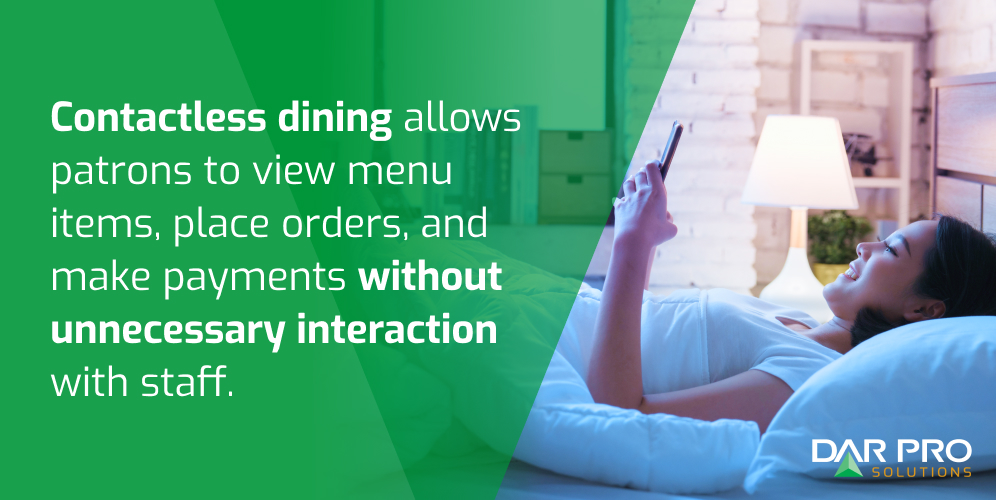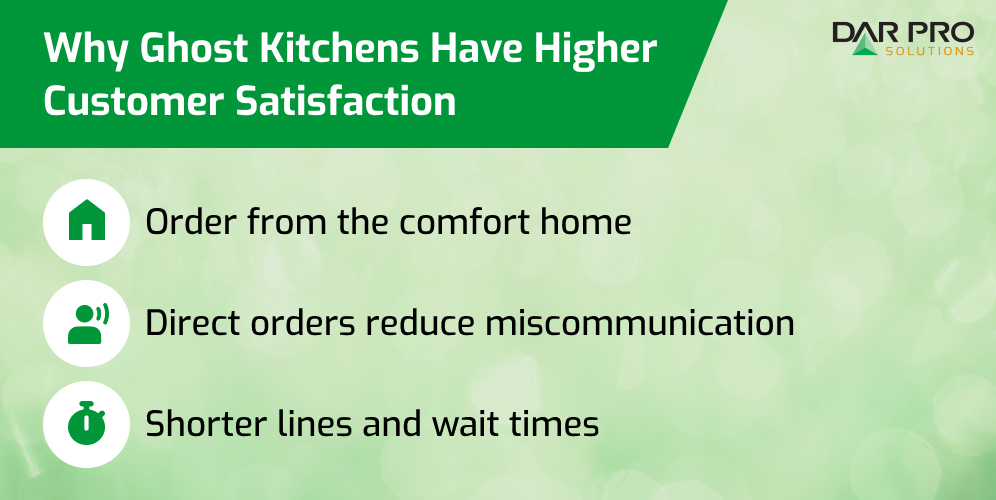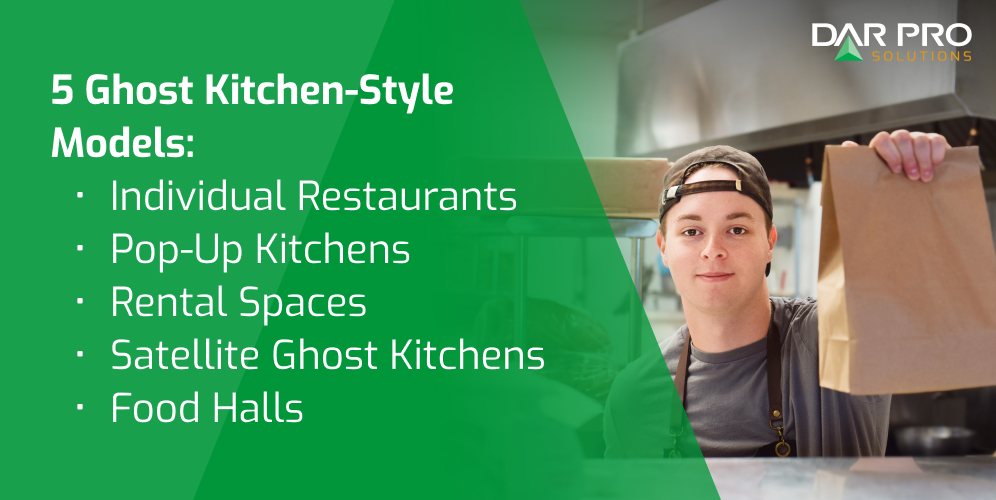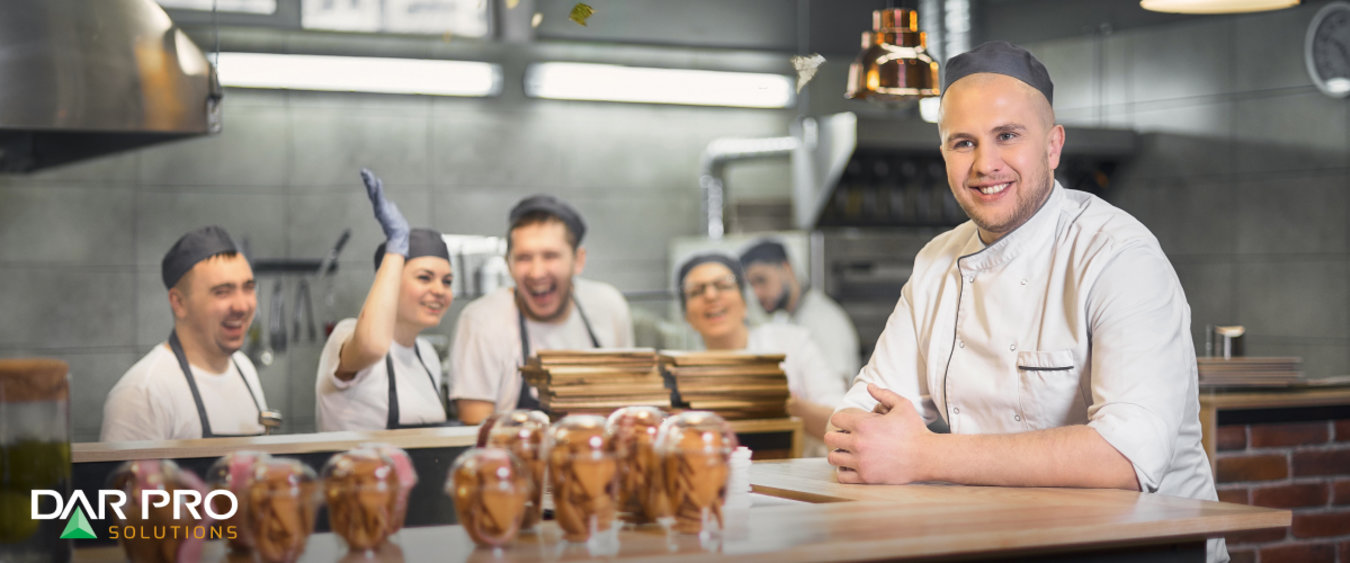You may think the reopening of public dining spaces spells the end for ghost kitchens and contactless dining options, but that's not the case. Restaurant Business predicts the models will long outlast the pandemic, with ghost restaurants expected to produce $300 million yearly sales. Euromonitor gauges they'll be a $1 trillion industry by 2030.
With ghost kitchens poised to be the future of contactless dining in 2023 and beyond, it's essential to consider how your industry and needs as a restaurant might evolve alongside them.
What is Contactless Dining?
Contactless dining, or the contactless restaurant model, allows patrons to view menu items, place orders, and make payments without unnecessary interaction with staff. Ideally, contactless dining enables customers to avoid touching public surface areas, which is why it gained popularity during the pandemic.

Three Components of Contactless Dining
Contactless ordering eliminates the need to handle currency, menus, or bill books. It also increases the likelihood of the customer’s order being to their liking, as they’re the ones directly placing it. Three critical components make up contactless dining:
Contactless Menu: Customers scan a QR code on the table or view menu recommendations through an online app
Contactless Ordering: Customers order menu items directly through an app
Contactless Payment: Customers provide payments and tips electronically
What is a Ghost Kitchen?
While the name might sound a little spooky, ghost kitchens have been around long before the COVID-19 pandemic. Also called "dark kitchens," "cloud kitchens," and "virtual kitchens," ghost kitchens are restaurants that operate with only a kitchen space.
Ghost kitchens occupy smaller spaces with less staff than traditional dine-in restaurants. They don’t require a physical storefront or customer seating. Some offer takeout or drive-thru, but for the most part, they operate entirely on delivery.
Since there is no restaurant-specific physical storefront or branding, multiple restaurants can produce and deliver orders from the same kitchen. They may even split operation and real estate costs.
How Profitable is a Ghost Kitchen?
Most traditional restaurant profit margins are slim, between 3-5%. Part of a ghost kitchen's appeal is the ability to make more than 5% because it eliminates the costs of front-of-house operation.
In the restaurant industry, the proprietor pays themselves half of the profit while investing the other half into the business. If your ghost kitchen's average monthly profit margin is 8%, you should make 4% of sales.
Like any traditional restaurant, ghost kitchens are an investment. The funding, labor, and time you invest in them will affect their success. Investing in the right strategies and technologies can push you toward success. Depending on your local food costs and key performance indicators (KPIs), expect your ghost kitchens to become profitable within the first two years of operation.

Why Are Ghost Restaurants So Popular?
You may wonder why an industry that provides a seemingly impersonal customer experience has become the new trend in dining. Two key reasons are lower restaurant operational costs and more customer convenience.
Lower Restaurant Operational Costs
It's obvious why ghost kitchens have become so popular with restaurant owners—they help lower input and operation costs. When you can exclusively focus on food preparation, you don't have to spend time and money on dining room decorations, maintenance, furnishings, or waitstaff.
Ghost kitchens embrace innovation, maximizing operational speeds with efficient Point of Sale (POS) systems and self-ordering kiosks or apps. Since less square footage is needed to accommodate them and they don't require a prime location, they significantly reduce real estate and rental costs.
Lower operational costs increase revenue for business owners, but ghost kitchens also lower customer prices. Contactless delivery provides a product in one of the most customer-friendly ways possible.
Ease for Customers
Contrary to popular belief, ghost kitchens have higher customer satisfaction than other dining options. Customers can order menu items, make special requests, and clarify any allergies from the comfort of their own homes. Direct orders limit the possibility of miscommunication from customers to waitstaff and waitstaff to kitchen staff, both in person and by telephone.
Most ghost kitchens operate through a streamlined delivery system. However, some allow customers to opt for pickup options like curbside ordering. If customers choose this option, their ease is sustained by shorter lines and wait times. They get to pick up their order after receiving a notification that it's ready.

Are There Drawbacks to Running a Ghost Kitchen?
Ghost kitchens have benefits, but there can be drawbacks to running them. The two most common disadvantages are unsatisfactory food quality and lack of customer feedback.
Unsatisfactory Food Quality
As convenient as delivery is, it will never match the freshness of a meal brought to the table directly from the kitchen. Because you eliminate the "kitchen to table" experience, you must ensure delivery doesn't diminish food quality.
Ghost kitchens must devote more attention to delivery packaging and speed while controlling the types of food they're sending out. Sometimes, no matter how delicious something tastes fresh from the oven, it doesn't hold up as a deliverable option. Cut these items from the menu to avoid potential disappointment.
Additionally, since delivery or carryout are the only options for customers, ghost kitchen entrepreneurs must carefully consider their packaging security measures. They must also monitor delivery times and radiuses to meet customer expectations for warm meals and timely service.
Lack of Customer Feedback
Most traditional restaurants interact with customers in person and gather feedback during these interactions. However, contactless dining eliminates in-person customer interaction. So how do you gauge what's working well and what isn't?
Ghost kitchen managers must be very intentional in the ways they gather feedback to determine customer satisfaction. If you invest in a ghost kitchen, provide easy, online ways for customers to give online feedback.
Pay attention to what your customers say about your food, ease of ordering, and delivery satisfaction. Your kitchen's success entirely depends on others' opinions, so do your best to meet their needs.
If you're thinking of opening a ghost kitchen but have yet to pull the trigger, ask yourself an important question. Which do your customers value more: the experience you provide or the food you sell? Only the second option is suitable for a ghost kitchen.
The Future of Ghost Kitchens
While the COVID-19 pandemic may have accelerated their growth, ghost kitchens are now here to stay. Successful models will adapt to the post-pandemic environment, expanding to include multiple sales channels.
Currently, there are multiple ghost kitchen-style models, including those below.

Individual Restaurants
An existing restaurant closes its doors for dine-in and provides online carryout and delivery options instead. This model was the simplest ghost kitchen form that became popular during the pandemic.
Pop-Up Kitchens
Also called incubator ghost kitchens, pop-up kitchens license, create, and deliver food from national brands.
Rental Spaces
Entrepreneurs rent out commercial kitchen spaces for delivery or carryout with no dine-in customers.
Satellite Ghost Kitchens
The staff prepares food in a commissary kitchen before distributing it to satellite locations.
Food Halls
Typically located in areas with high walk-through traffic, these stores allow customers to place orders with multiple cuisines for dine-in, carryout, or delivery.
Reliable Partners in an Ever-Changing Industry
Ghost kitchens are innovative in cutting operation costs and offering a contactless experience. However, there are better options for some restaurants. It's vital to consider their pros and cons before investing your time, effort, and finances into opening one.
The F&B sector is an ever-growing and ever-changing industry. Whether operating a traditional restaurant or switching to a ghost kitchen, you should partner with reputable companies that will withstand changing trends. Though ghost kitchens don’t have all of the same needs as a traditional restaurant, they do share some qualities, including the need to dispose of used cooking oil.
Your operation is unique, and so are your recycling needs. DAR PRO Solutions helps you profit from something that would otherwise be thrown out—used cooking oil. Regardless of the size of your operation, we have the containment and collection equipment to fit your food-waste needs. Contact us today to get started!
Contact Sales
For customer service inquiries call our toll free number (855) 327-7761
By submitting this form I agree to the privacy policy including the usage of contact details to contact me for marketing purposes.
